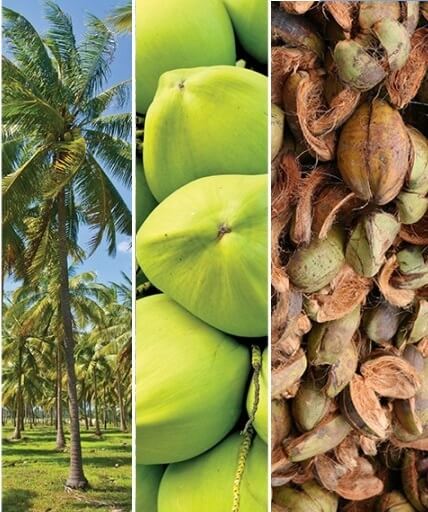Using Coir
Using Coir
COIR is a useful natural fibre that is taken from the coconut fruit’s mesocarp tissue, or husk. The term “The Golden Fibre” refers to fibre that, when cleaned after being removed from coconut husk, is often golden in colour.
The tough husk of a coconut is called coir. The coir shields the fruit well enough for it to survive months floating on ocean currents before washing up on a sandy shore, where it may sprout and grow into a tree, if it has enough fresh water, as all the other nutrients it needs have been carried along with the seed. The fruit is tough and naturally resistant to seawater. These qualities make the fibres very useful in garden mulch, aquarium filters, cordage, and outdoor mats.
Chemical-Free
Fresh & Healthy
100% Organic

Composition of Coir Fiber
The individual fibre cells are formed of cellulose and have thick, hollow walls. They are light in colour while they are immature, but as a layer of lignin is developed on their walls, they eventually harden and turn yellow. Compared to fibres like flax and cotton, mature brown coir fibres have more lignin and less cellulose, making them stronger but less flexible. They are composed of tiny threads that are 10 to 20 micrometres in diameter and less than 0.05 inches (1.3 mm) long. White fibre is more delicate and smooth, but it is also weaker. The only natural fibre that can withstand being damaged by salt water is the coir fibre, which is comparatively impervious.
Brown Fibre
To swell and soften the fibres, the fibrous husks are submerged in pits or nets of slowly moving water for an extended period of time. Wet-milling, a procedure that separates the long bristle fibres from the shorter mattress fibres beneath the nut’s skin. The mattress fibres are dried, baled, and sifted to eliminate dirt and other debris. In order to maintain its flexibility for the creation of “twisted” fibre, certain mattress fibre is permitted to hold onto more moisture. The coir fibre may be bent without breaking and retains a curl as though it were constantly waved.
White Fibre
For up to ten months, the immature husks are suspended in a river or a pit filled with water. Retting is the process by which microorganisms release fibres by dissolving the plant tissues that surround them. The long fibres are then manually separated from the husk segments after which they are dried and cleaned. Clean fibre is ready to be spun into yarn with a spinning wheel or a straightforward one-handed method.
Applications
Mattresses, sacks, doormats, and brushes all employ brown coir. A little portion is also used to create thread. Mattresses can be filled with coiled brown coir fibre pads that have been needle-felted (a machine process that binds the fibres together). These pads can also be used to halt erosion on river banks and slopes. In order to be used as upholstery padding for the European automotive industry, a large amount of brown coir pads are rubberized (coir that has had rubber latex sprayed on it to bind the fibres together). The substance is also employed in packaging and insulation. White coir is mostly used to make rope. The finer grades of bristle and white fibre are woven into mats using either hand or mechanised looms.
Major Producers
A total of 250,000 tonnes of coir fibre are produced worldwide. Particularly significant in various parts of the developing world is the coir fibre sector. 60% of the white coir fibre consumed worldwide is produced in India, primarily in Kerala State’s coastal region. 36% of the world’s total production of brown fibre comes from Sri Lanka. The nations of origin, primarily India, utilise more than 50% of the coir fibre produced annually worldwide.
Coir Facts
COIR is a useful natural fibre that is taken from the coconut fruit’s mesocarp tissue, or husk. 20% to 30% of the husk is made up of fibres of various lengths. The long fibres are taken from the ground-up husk and employed in a variety of industrial processes, including the production of rope and mats. The remainder is referred to as waste-grade coir and is made up of short and medium-length fibres as well as pith tissue. The remainder, known as coir pith, is produced by screening the trash grade coir to remove some or all of the fibre.
